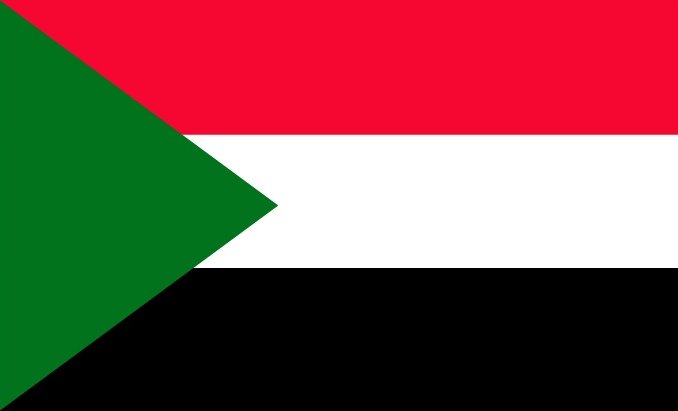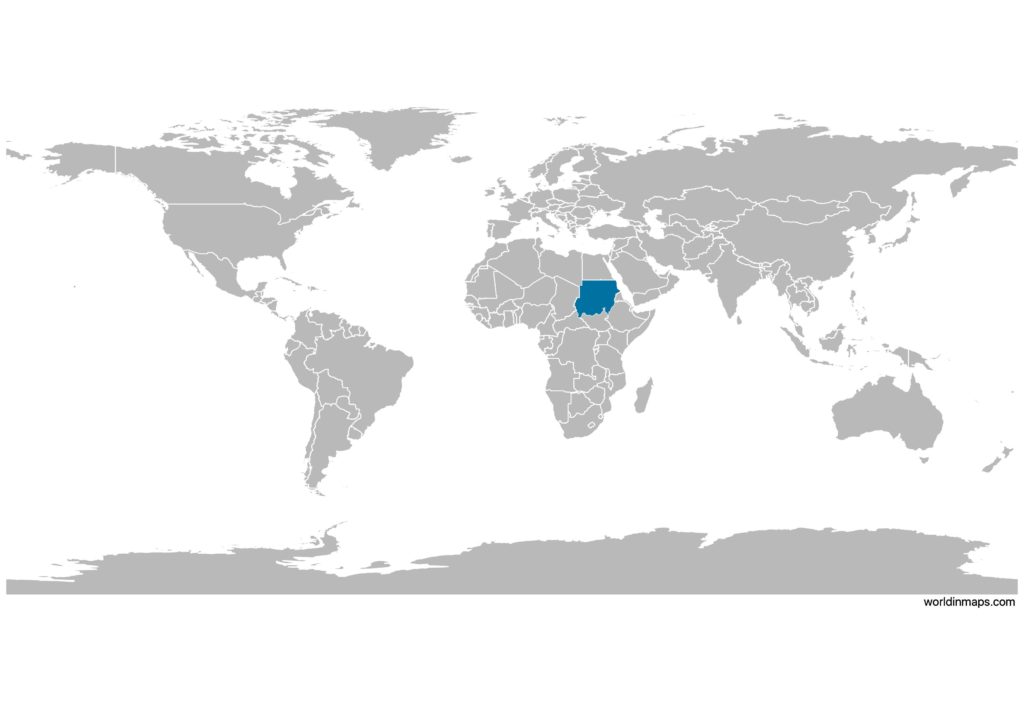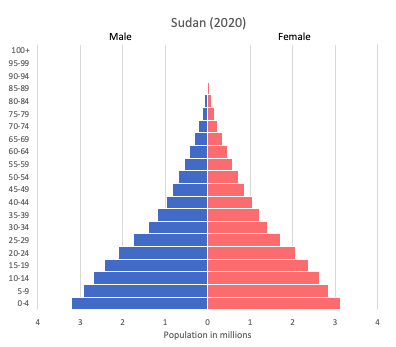Sudan

| Government | |
| Name | Republic of the Sudan |
| Arabic | جمهورية السودان Jumhūriyyat as-Sūdān |
| Government type | presidential republic |
| Capital | Khartoum (1,410,858 (2008)) |
| Currency | Sudanese pound (SDG) |
| People | |
| Population (2020) | 43,849,269 (33rd) |
| Density of population | 21.3 P/km2 |
| Nationality | Sudanese |
| Official languages | |
| Arabic | |
| English | |
| Ethnic groups | |
| unspecified Sudanese Arab (approximately 70%) | |
| Fur | |
| Beja | |
| Nuba | |
| Fallata | |
| Religions | |
| Sunni Muslim | |
| small Christian minority | |
| Life expectancy (2020) | |
| Male | 64.3 years |
| Female | 68.8 years |
| Total population | 66.5 years (186th) |
| Homicides | |
| Total (2008) | 5.1 per 100,000 people (61st) |
| Geography | |
| Land area | 1,731,671 km2 |
| water area | 129,813 km2 |
| total area | 1,861,484 km2 (17th) |
| Mean elevation | 568 m |
| Lowest point | |
| Red Sea | 0 m |
| Highest point | |
| Jabal Marrah | 3,042 m |
| Land use (2011) | |
| Agricultural land | 100% |
| Arable land | 15.7% |
| Permanent crops | 0.2% |
| Permanent pasture | 84.2% |
| Forest | 0% |
| Other | 0% |
| Urbanization | |
| Urban population (2020) | 35.3% |
| Rate of urbanization | 3.17% annual rate of change (2015 – 2020) |
| Economy | |
| Labor force (2007) | 11.92 million (49th) |
| Labor force by occupation (1998) | |
| Agriculture | 80% |
| Industry | 7% |
| Services | 13% |
| Unemployment rate (2017) | 19.6% (184th) |
| GDP (PPP) (estimate 2018) | |
| Total | $177.678 billion |
| Per capita | $4,232 |
| GDP (nominal) (estimate 2018) | |
| Total | $33.903 billion |
| Per capita | $808 |
| GDP by sector (estimate 2017) | |
| Agriculture | 39.6% |
| Industry | 2.6% |
| Services | 57.8% |
| Exports (2017) | $4.1 billion (116th) |
| Exports partners (2017) | |
| UAE | 55.5% |
| Egypt | 14.7% |
| Saudi Arabia | 8.8% |
| Imports (2017) | $8.22 billion (109th) |
| Imports partners (2017) | |
| UAE | 12.7% |
| Egypt | 10.6% |
| India | 10.5% |
| Turkey | 10.2% |
| Japan | 7.6% |
| Saudi Arabia | 6% |
| Germany | 4.6% |
Sudan on the world map

Sudan top 10 largest cities (2008)
- Omdurman (1,849,659)
- Khartoum (1,410,858)
- Khartoum North (1,012,211)
- Nyala (492,984)
- Port Sudan (394,561)
- El-Obeid (345,126)
- Kassala (298,529)
- Wad Madani (289,482)
- El-Gadarif (269,395)
- Al-Fashir (217,827)
Demography
Population pyramid

Age structure data
Estimate for 2020:
- 0-14 years: 42.01% (male 9,726,937/female 9,414,988)
- 15-24 years: 20.94% (male 4,852,903/female 4,687,664)
- 25-54 years: 29.89% (male 6,633,567/female 6,986,241)
- 55-64 years: 4.13% (male 956,633/female 923,688)
- 65 years and over: 3.03% (male 729,214/female 649,721)
Remark: the age structure of a population affects a nation’s key socioeconomic issues. Countries with young populations (high percentage under age 15) need to invest more in schools, while countries with older populations (high percentage ages 65 and over) need to invest more in the health sector. The age structure can also be used to help predict potential political issues. For example, the rapid growth of a young adult population unable to find employment can lead to unrest.
Population from 1950 to 2020
Source: United Nations, Department of Economic and Social Affairs, Population Division (2019). World Population Prospects 2019, Online Edition. Rev. 1.
Evolution of the life expectancy from 1960 to 2018
Source: World Development Indicators, The World Bank
Major rivers
Economy
Agriculture:
cotton, groundnuts (peanuts), sorghum, millet, wheat, gum Arabic, sugarcane, cassava (manioc, tapioca), mangoes, papaya, bananas, sweet potatoes, sesame seeds, animal feed, sheep and other livestock
Industries:
oil, cotton ginning, textiles, cement, edible oils, sugar, soap distilling, shoes, petroleum refining, pharmaceuticals, armaments, automobile/light truck assembly, milling
Exports – commodities:
gold, oil and petroleum products, cotton, sesame, livestock, peanuts, gum Arabic, sugar
Imports – commodities:
foodstuffs, manufactured goods, refinery and transport equipment, medicines, chemicals, textiles, wheat
Time zone and current time in Sudan
Go to our interactive map to get the current time in Sudan